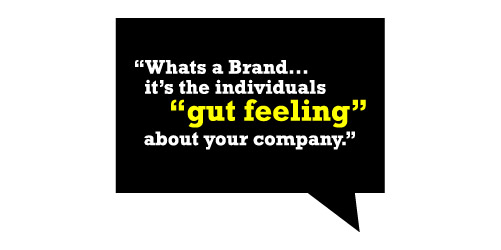Blog
What is a “Brand”?

I read a lot of industry produced articles and papers on branding, all have one thing in common, the message is confusing, they use a plethora of “tech talk” and what I can only describe as gibberish, so let’s start anew.
First off a logo is not a brand; a logo is a symbol or mark used to represent a company or person usually simple in design and flat in colour, although this generally does not hold fast in our day and age.
The word “logo” derives from the Greek word Logo-gram, ‘logos’ meaning ‘word’ and ‘gram’ meaning ‘what is written’. The word ‘Logotype’ is its proper form, but through time and the nature of language it has been shortened to ‘Logo’. But the important thing is a logo is part of an identity system, so when you hear the term Logo banded around, what people really mean is trademark.

Your trademark lets the consumer know through consistency and familiarity, who the service or product is from and if they can trust it, because as humans, we are intuitive and emotionally driven, trust is the foundation for any brand; think about Coca-Cola, what do you think about? Maybe it’s the trademark we all know and love, maybe the iconic bottle, most probably it’s that great taste, but the important thing is that when you pick up a bottle of Coke you know that you can trust it, you trust that it’s going to taste like coke, you trust it’s going to make you feel good and quench your thirst.
Why?
Because you know the brand, it’s been a part of all our lives for so long, you know what to expect and it always meets your expectations, and as long as the guys at Coca-Cola keep meeting those expectations they will remain the premium in their market.
Secondly, packaging does not make a brand, packaging much like the trademark is there as an identifying system used to bring harmony and conformity, and it also offers additional information on products and services.
This brings us to products, which also is not the brand, rather, it is your offering to the world, what will bring differentiation to your company, because unless you have a new invention, most products already exist, but you will set your product apart from another by carefully considering the things that make it unique.
This of course is a very brief overview of different systems within a company but demonstrates that the things you probably first think of are not the brand itself. There are a multitude of other systems we could discuss, but it’s not the purpose of this article, so let’s cut to the chase… what is a brand?

“A brand is a person’s emotional response” — Marty Neumeier, a well known brand collaboration expert — said. “It’s the individuals “gut feeling” about your company, product or service”.
And it really is about individuals, you may have a demographic or target market, but individuals make up the masses, and when a multitude of individuals come to the same conclusion about your company, product or service then you have yourself a brand and “Brand Management” is about controlling this non tangible human feeling/emotion. This is what builds all of the strongest brands we know today.
Take Apple for instance, they captured peoples imagination’s and hearts with not only their great products, but with the advertising and packaging, look at their iconic silhouette dancers advertisement that adorned not only printed materials but television ads as well, for the release of their original iPod, before Apple came along advertising technology was about technicalities and specifications but Apple threw that out the window and created a product you wanted, not one you needed.

Getting individuals to ‘Want’ your products is a feat that all brand managers should be aiming for, because when you ‘Want’ something it’s an emotional response, it’s a purchase out of emotion or an impulse, not one made on necessity.
So a brand is about controlling the emotions and feelings of your consumer’s or the people you want to be your consumers, being able to come up with a campaign that’s going to capture the heart, or the imagination of people, and one of the only ways to manage brand is by expert use of not only the strategy behind a clever or intelligent campaign but the execution of design within the campaign, basically the concept has to be just as great as the execution. This is what will be discussed in the next article…